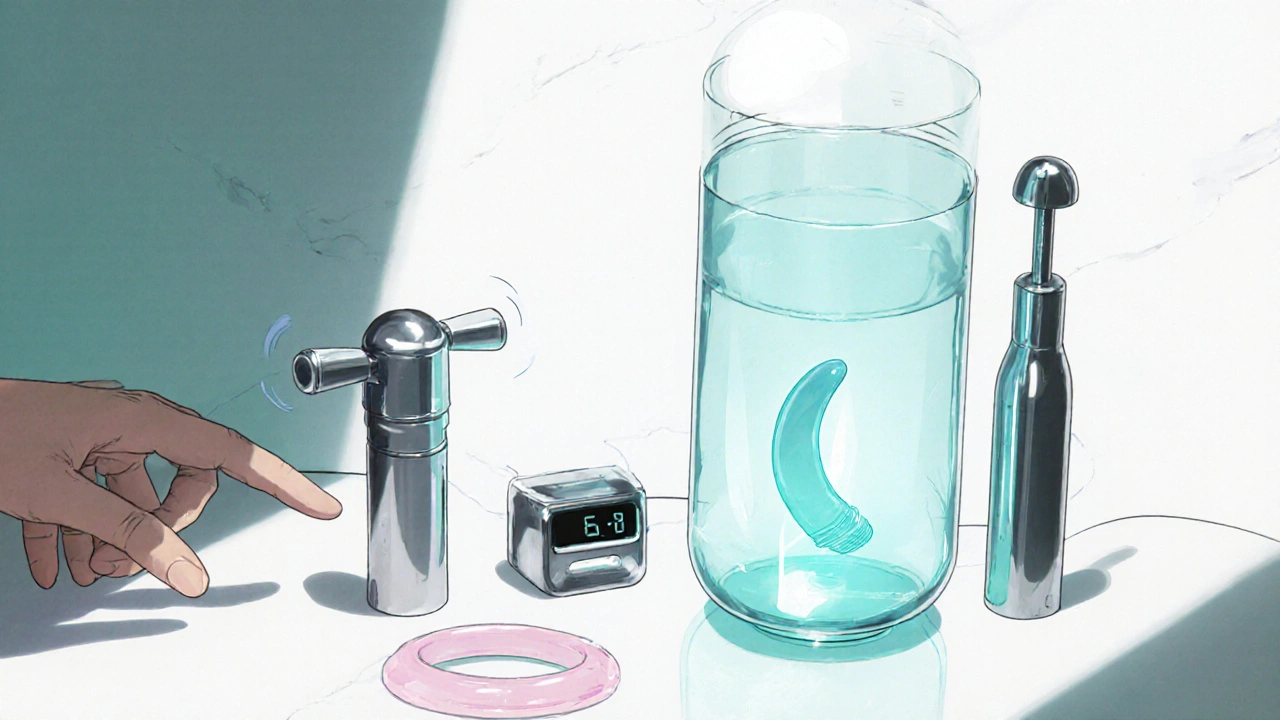Vacuum Device Candidate Assessment
This interactive tool helps determine if a vacuum erectile device is the right choice for you based on your medical history, treatment preferences, and lifestyle. Answer the following questions to see if you're a good candidate.
Imagine trying to keep the spark alive, but the most basic part of intimacy feels broken. For many men, erectile dysfunction-clinically called Erectile Dysfunction is the inability to achieve or maintain a penile erection sufficient for satisfactory sexual performance-turns that scenario into a daily frustration. One of the oldest, non‑drug options on the market is the Vacuum Erectile Device (often called a penile pump). It creates a pressure‑sealed chamber around the penis, drawing blood in to produce an erection without medication.
How a Vacuum Erectile Device Works
The device consists of three parts: a clear cylinder, a manual or battery‑powered pump, and a tension ring. You place the cylinder over the flaccid penis, activate the pump, and the vacuum pulls blood into the corpora cavernosa. Once the shaft is firm, a slippery silicone ring slides onto the base, locking the blood in place for up to 30 minutes. The whole process mimics a natural erection but without the hormonal or enzymatic triggers that oral pills rely on.
Pros: Why Some Men Prefer the Vacuum Approach
- Drug‑free solution: No need for prescriptions, making it safe for men who can’t take PDE5 Inhibitor medications such as sildenafil or tadalafil due to heart conditions or nitrate use.
- Immediate results: The erection appears within minutes, which is helpful for spontaneous intimacy.
- Cost‑effectiveness: A quality pump costs between £150‑£300, far cheaper than ongoing drug subscriptions.
- Dual benefit: Regular use can improve penile tissue health by encouraging blood flow, potentially reducing long‑term vascular damage.
- Partner involvement: The visual nature of the device often turns a medical tool into a shared, playful experience.
Cons: Drawbacks You Need to Know
- Noise and bulk: Manual pumps can be noisy, and the cylinder may feel awkward during foreplay.
- Risk of bruising: Over‑pumping or leaving the ring on too long can cause petechiae or soreness.
- Reduced spontaneity: The set‑up takes a few minutes, which can interrupt the mood.
- Temperature sensitivity: Some men report that erections feel cooler because the device draws blood from the lower body.
- Learning curve: Proper seal and pressure require practice; many first‑time users feel discouraged.

How It Stacks Up Against Other Treatments
| Option | Mechanism | Cost (UK) | Onset | Main Drawbacks |
|---|---|---|---|---|
| Vacuum Erectile Device | Creates negative pressure to draw blood | £150‑£300 (one‑time) | Minutes | Noise, set‑up time, possible bruising |
| PDE5 Inhibitor (e.g., Viagra) | Inhibits phosphodiesterase‑5, boosting cGMP | £8‑£30 per tablet | 30‑60 min | Contraindicated with nitrates, side effects |
| Intracavernosal Injection | Direct vasodilator injection | £30‑£60 per dose | Minutes | Pain, risk of priapism, needle anxiety |
| Penile Prosthesis (Penile Prosthesis) | Surgical implants provide rigidity | £4,000‑£7,000 (one‑time) | Weeks (post‑surgery) | Invasive surgery, infection risk |
| Low‑Intensity Shockwave Therapy (Shockwave Therapy) | Acoustic waves improve micro‑circulation | £2,000‑£4,500 (course) | Weeks to months | Limited long‑term data, cost |
Who Might Benefit Most from a Vacuum Device?
Not every case of erectile dysfunction calls for the same fix. The ideal candidates for a vacuum pump usually share these traits:
- They cannot safely take oral medication due to heart disease, blood pressure meds, or nitrate therapy.
- They prefer a reversible, drug‑free approach.
- They have a partner who’s open to trying the device together.
- They have enough manual dexterity to create a seal and handle the pump.
If you fall into any of these categories, the vacuum erectile device could be a practical first step before moving to more invasive measures.
Step‑by‑Step Guide: Using a Vacuum Pump Correctly
- Prepare the kit: Clean the cylinder, pump, and ring with warm water and mild soap. Dry thoroughly.
- Create a seal: Apply a water‑based lubricant to the base of the penis and the inside of the cylinder. Press the cylinder firmly against the skin, ensuring no air escapes.
- Generate vacuum: Pump manually or activate the battery‑powered pump until the penis feels firm-typically 5‑7 strokes for manual models.
- Apply the tension ring: While still under vacuum, slide the silicone ring onto the base. Keep the ring on for no longer than 30 minutes.
- Enjoy intimacy: Remove the cylinder, keep the ring in place throughout intercourse, and release it afterwards by gently sliding it off.
- Post‑use care: Inspect the penis for bruising or discoloration. Store the pump in a clean, dry place.
Practicing this routine a few times a week can build confidence and reduce the learning curve dramatically.

Complementary Strategies to Boost Success
Even though the vacuum pump can work solo, many clinicians suggest pairing it with other lifestyle or therapeutic measures:
- Pelvic Floor Exercise (Kegels): Strengthening the bulbocavernosus muscle improves blood retention.
- Testosterone Therapy: For men with low T, supplementation can raise libido and response to any device.
- Sexual Health Counseling: Open dialogue with a therapist or partner reduces anxiety, a major ED trigger.
Common Myths Debunked
Myth 1: “Vacuum pumps make the penis permanently smaller.”
Reality: The device does not alter penile length; any perceived shrinkage is usually temporary due to reduced blood flow after removing the ring.
Myth 2: “Only older men need them.”
Reality: Even younger men with diabetes or spinal injuries benefit from a non‑pharmacologic option.
Myth 3: “They’re only for men who can’t have sex at all.”
Reality: Many couples use the pump to enhance performance, not just as a rescue tool.
Frequently Asked Questions
Is a vacuum pump safe for long‑term use?
When used according to the manufacturer’s instructions and with the tension ring removed after 30 minutes, it’s considered safe indefinitely. Regularly check for bruising or numbness, and pause usage if you notice persistent pain.
Can I use a vacuum pump if I have a penile implant?
No. The implant already provides rigidity, and adding negative pressure can damage the device or surrounding tissue.
Do I need a prescription to buy a vacuum pump?
In the UK, vacuum pumps are sold over‑the‑counter as medical devices, so no prescription is required.
How does the effectiveness of a vacuum pump compare to oral meds?
Clinical studies show that about 70 % of men achieve a satisfactory erection with a pump, while oral PDE5 inhibitors report success rates around 60‑80 % depending on the underlying cause. The key difference is that pumps work mechanically, bypassing the vascular‑neurochemical pathways that meds target.
Can my partner feel the pump during sex?
The cylinder is removed before intercourse, so only the tension ring stays on. Most couples report that the ring feels like a gentle band and doesn’t interfere with sensation.
Choosing the right erectile dysfunction solution isn’t a one‑size‑fits‑all decision. The vacuum erectile device offers a low‑cost, drug‑free alternative that works for many men who can’t or don’t want to take pills. Weigh the pros-immediate results, safety, affordability-against the cons-noise, set‑up time, possible bruising-and decide if it fits your lifestyle. When in doubt, a quick chat with a GP or urologist can help you map a personalised plan that might combine the pump with lifestyle tweaks, hormone checks, or other therapies.









Comments (10)
Kirsten Youtsey
October 20, 2025 AT 17:26 PMThe premise that a mechanical device can substitute pharmacology is not merely novel; it reflects a broader distrust of pharmaceutical hegemony. Historically, the medical establishment has colluded with drug manufacturers to marginalize low‑tech solutions. By championing a vacuum pump, one implicitly exposes the profit‑driven agenda that keeps cheap alternatives hidden. Moreover, the device’s reliance on negative pressure sidesteps the iatrogenic side effects that pharmaceutical agents invariably introduce. Critics who dismiss the pump as archaic are often unwittingly echoing the same corporate narratives that downplay affordable care. Users should remain vigilant about the underlying motives that shape medical recommendations. While the pump’s efficacy is supported by clinical data, the surrounding discourse is saturated with bias. Ultimately, informed choice demands scrutiny of both the technology and the interests that promote it.
Natalie Morgan
October 20, 2025 AT 19:06 PMExploring the mechanics without hype can empower many who seek a discreet solution.
Rajesh Myadam
October 20, 2025 AT 21:53 PMI understand that navigating erectile dysfunction can feel isolating, and the vacuum pump offers a tangible way to regain confidence. The step‑by‑step guide you shared demystifies the process, making it less intimidating for first‑time users. It’s also encouraging that the device can be combined with pelvic floor exercises to enhance outcomes naturally. Remember to monitor any bruising and give yourself time to master the seal; patience often leads to better results. Open communication with a partner about the experience can turn a clinical tool into a shared ritual, reducing anxiety for both parties. If you ever feel uncertain, consulting a urologist can provide personalized reassurance without pushing medication. Overall, the pump represents a pragmatic, low‑cost option that aligns with many people’s desire for autonomy over their sexual health.
Andrew Hernandez
October 21, 2025 AT 02:03 AMThe vacuum approach respects personal agency while avoiding systemic drug interactions, which is especially important for those on nitrate therapy. Its over‑the-counter availability sidesteps prescription hurdles, making it accessible to a broader demographic. Users should keep the equipment clean and follow the 30‑minute limit to prevent tissue irritation. In practice, many couples report that the visual aspect of the pump adds a playful dimension to intimacy. Maintaining a relaxed atmosphere can mitigate the perceived bulkiness of the cylinder during foreplay. Overall, it’s a sensible balance between effectiveness and safety.
laura wood
October 21, 2025 AT 06:13 AMFrom an empathetic standpoint, the vacuum device can restore a sense of normalcy for partners who feel the strain of ED. The tactile feedback of the tension ring often reassures both individuals that the erection is sustained, reducing performance pressure. It’s vital to emphasize gentle handling and adequate lubrication to avoid discomfort. By integrating the pump into a routine rather than a one‑off event, many couples notice a gradual improvement in confidence. Sharing the experience openly fosters intimacy and diminishes the stigma that often surrounds sexual health discussions.
Kate McKay
October 21, 2025 AT 11:46 AMChoosing the right erectile aid is a deeply personal decision, and the vacuum pump deserves a thorough, balanced evaluation. First, the immediate erection it provides can be a game‑changer for spontaneous intimacy, eliminating the waiting period associated with oral medications. Second, the device’s drug‑free nature eliminates concerns about interactions with antihypertensive or cardiac drugs, a crucial factor for patients with comorbidities. Third, the upfront cost, while seemingly high, becomes economical over time compared to the recurring expense of PDE5 inhibitors. Fourth, regular use can enhance penile blood flow, potentially contributing to long‑term vascular health, a benefit not often highlighted in marketing materials. Fifth, the tactile sensation of the tension ring can be incorporated into foreplay, turning a clinical tool into a source of shared pleasure. Sixth, the learning curve, though initially steep, is overcome with practice and patience, much like mastering any new skill. Seventh, the discreet nature of the pump allows for private use without the stigma of pharmacy visits. Eighth, the device is compatible with many other health strategies, such as lifestyle modifications, pelvic floor strengthening, and counseling, creating a holistic treatment plan. Ninth, the risk of bruising or petechiae is mitigated by adhering to manufacturer guidelines and respecting the 30‑minute limit. Tenth, many users report that the device’s presence encourages open communication with partners, fostering a supportive environment. Eleventh, the absence of systemic side effects means there’s no need for medical monitoring beyond the usual check‑ups. Twelfth, the pump’s versatility accommodates varying penis sizes, as different cylinder diameters are available. Thirteenth, for men who have experienced failure with oral meds, the pump offers an evidence‑based alternative with a success rate comparable to pharmaceuticals. Fourteenth, the device’s simplicity means it can be used in a range of settings, from hotel rooms to home bedrooms. Fifteenth, the psychological boost from regaining control over sexual performance can improve overall mood and relationship satisfaction. Finally, consulting a qualified urologist can help tailor the usage protocol to individual health profiles, ensuring safety and efficacy throughout the journey.
Demetri Huyler
October 21, 2025 AT 22:53 PMHonestly, the pump is a proud American solution that outshines foreign pharmaceutical conspiracies.
JessicaAnn Sutton
October 22, 2025 AT 10:00 AMIt is morally indefensible to overlook the ethical implications of relying on a device that commodifies intimate experiences for profit. The vacuum pump, when presented without transparent disclosure of potential risks, becomes a tool that exploits vulnerable individuals seeking relief. A rigorous, evidence‑based endorsement must accompany any recommendation, ensuring that patients are fully informed about bruising, temperature changes, and the psychological impact of device dependence. Moreover, healthcare providers bear the responsibility to frame the conversation within a broader context of sexual health education, rather than reducing it to a mere sales pitch. Only through such conscientious discourse can we uphold the dignity of those confronting erectile dysfunction.
Israel Emory
October 22, 2025 AT 21:06 PMWell, let’s be crystal‑clear: the vacuum pump offers a mechanical, drug‑free path; however, it is not a panacea; users must respect the 30‑minute ring limit, maintain hygiene, and communicate openly with partners; otherwise, the risk of bruising, reduced sensation, or awkwardness skyrockets; in short, success hinges on proper technique, realistic expectations, and a supportive environment.
barnabas jacob
October 23, 2025 AT 08:13 AMYo, the device’s biomechanics are legit, but if you don’t calibrate suction pressure you’ll just get a suboptimal hemodynamic response and end up with micro‑vascular trauma – that’s why protocol adherence is key.